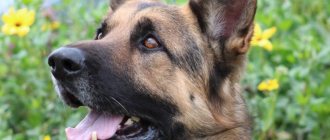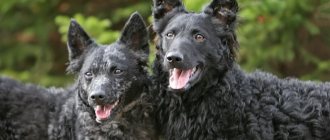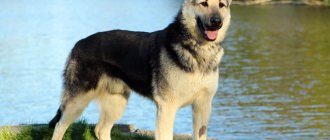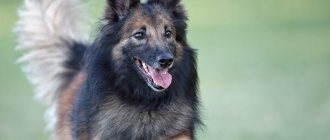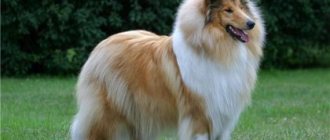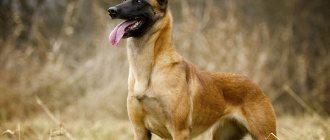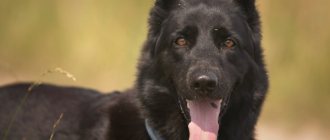| Intelligence: |
| Aggressiveness: |
| For security: |
| For children: |
| Training: |
| Difficulty in care: |
The Shilon Shepherd is a young and not fully formed breed. German shepherd breeder Tina Barber began research into developing a new breed in 1974 in the USA. Her goal was to create a unique dog with the best working qualities of a German shepherd, the mental abilities of the Thuringian shepherd dogs - the ancestors of modern “Germans”, and the external characteristics of mountain shepherds.
The American breeder carried out the selection work in her Shilon shepherd kennel. Today, the Shilon Shepherd Dog, abbreviated as Shilon , is just beginning to gain popularity due to its phenomenal intelligence and quick learning ability. The dog copes well with the role of a guide and has proven itself well as a herding dog, guard dog, and companion.
Breed standard
For the first time, a shepherd dog bred in the Shilon kennel was recognized in 1990 by the International Canine Federation. Since then, this breed has been registered in the documents of the participants as the Shilon Shepherd Dog. There is no official breed standard, as selection work is still being carried out to breed dogs with certain properties. However, there are a number of requirements for the size, appearance and color of dogs of this breed.
- Weight: males 54 – 72 kg; females 36 – 54 kg.
- Height: males 71 – 76 cm; females 66 – 71 cm.
- Life expectancy: 10 – 14 years .
Origin story
According to research, shepherd breeding has always been associated with herding work and the domestication of livestock. Initial information dates back to the 8th millennium BC. In those days, the tasks of dogs included protecting livestock from attacks by wild animals and accompanying them on foot. A little later, the shepherd began to be used as a service dog, which was able to participate in military events and help in protecting the territory.
Gradually the habitat expanded. In the Middle Ages, representatives typical of the area where the selection was carried out appeared. Therefore, many breeds are named after the birthplace of the breed. Some dogs are completely modified to meet the requirements of the breeders. Some are considered almost extinct. Work continues to restore the population of rare breeds. Absolutely new, previously unknown ones appear. Breeding work is carried out to obtain the best qualities among representatives.
Appearance
The Shilon is a larger dog compared to its German and Eastern European counterparts. The physique is proportional and powerful. The head is medium in size, with an elongated muzzle characteristic of shepherd dogs. Dark brown eyes set close together. The ears are small, erect, turned forward, and covered with longer hair.
The jaws are small in size, with a correct bite. The neck is of medium length, quite wide in girth, covered with thick long hair. The back is much wider and longer than that of the German Shepherd. Has a slight slope towards the tail. Shilons have a very developed wide chest. The front paws are large and widely spaced. The hind legs are strong and muscular. The tail is set low, slightly curved, and covered with long hair.
Dogs have two types of fur:
- Smooth, medium length, upper hairs of medium hardness, soft undercoat. The cover is thicker in the neck, chest, paws, and belly.
- The plush coat is very soft and has a silky undercoat. On the neck and chest the hair is very long, resembling a mane.
Color
Most often, Shilon Shepherds have the color of their German and Eastern European counterparts - black and tan, dark brown. Some dogs are completely black or white, black with a hint of silver.
Puppies
Briard babies are well-fed, have clear eyes and a moist nose. They are active, but do not show aggression, are not afraid of people, and are willing to make contact.
French Briard puppies have thick and long hair, a large head, powerful jaws, straight posture, a wide chest and a long tail.
During puppyhood, Briards are very active, they strive to chew on everything they can get their hands on. But you can’t scold them, they will begin to withdraw into themselves. It’s just worth preparing the apartment for a new guest in advance, putting valuables and shoes out of reach, buying more toys, hiding dangerous things (wires, sharp and piercing objects).
The French Briard breed is endowed with high intelligence; puppies quickly learn to walk and tolerate being taken for a walk to go to the toilet. Shepherds, like human children, require special attention, affection and love.
Character
The most important difference between a Shilon and a “German” is its flexible and balanced character . The Shilon Shepherd is simply created to be a reliable friend and companion for a family with small children, as it is not capable of showing aggression towards people. The dog gets along well with other pets.
During walks, he reacts calmly to other dogs and will never be the first to start a conflict. Shilon treats all people kindly, even strangers. However, with proper training of security skills, the dog will treat strangers with greater caution.
Vaccinations and susceptibility to disease
The Briard dog has a strong immune system. But the dog is susceptible to genetic diseases:
- hip dysplasia;
- "night blindness";
- retinal atrophy;
- thyroiditis;
- cancerous tumors;
- volvulus of the stomach.
The Briard breed is prone to allergies. It is most often caused by food and insect bites.
Despite the good health that the breed is endowed with, it is necessary to undergo mandatory vaccinations against enteritis, canine distemper, and rabies. The first vaccination for a Briard is carried out at the age of 1.5–2 months, then the veterinarian will schedule the subsequent ones.
Content
The Shilon Shepherd, like the German one, is unpretentious in its maintenance . She feels equally comfortable both indoors and outdoors. The dog is easy to train, and from the first time understands how to behave in the house. Shepherds are very active dogs, and they definitely need a lot of space to walk and play. Therefore, it is necessary to walk Shilons in parks and open areas.
Dogs love active games based on throwing a stick, ball, or disc. During such exercises, the dog trains attentiveness, agility, and speed.
How to choose the right puppy
You should only buy a purebred animal from a nursery with a good reputation, and not cheaply from an amateur breeder. In childhood, French Shepherd puppies are similar to mongrels, and many unscrupulous people sell babies found under the stairs of a house or in the basement.
When choosing a Briard, pay attention to its health. Check for the presence of an umbilical hernia or indigestion by looking under the puppy's tail. If your baby has diarrhea, traces of feces will be visible on the fur.
Trust a cattery that tests Briards for congenital hip dysplasia, this is a sore spot in the breed. It is difficult for an inexperienced person to identify the disease in puppies; it will worsen as the French Shepherd grows.
You also need to pay attention to the baby’s parents. Dogs must be healthy, kept in a warm, dry and bright place, and fed properly. The coat of a French Shepherd is an important detail. If it is bad in at least one of the parents, then there is a high probability that the cub will inherit a low-quality trait.
Usually people try to take possession of the largest and most well-fed puppy in the litter, but this cannot be done when choosing a Briard dog. Most likely, when this one grows up, it will not fit into the breed standards and will be larger.
Care
The Shilon Shepherd does not require special care , but the presence of a fairly long and thick coat requires frequent brushing to prevent the appearance of tangles. Despite the fact that the dog loves water treatments, you should not wash it often.
When washed with detergents, the fatty layer from the coat, which has a protective function, is washed off. Therefore, it is recommended to wipe your dog with a damp towel after walks. Hygienic cleaning of eyes and ears is a standard procedure for caring for a dog of any breed.
Shepherds, part 4
The wolf tamed by man became a dog. This happened about 12 thousand years ago in several areas of the world at the same time. The friendship between man and dog began a long time ago. Always and everywhere - during war and in peacetime, in wealth and poverty, in art, hunting, sports, scientific research - a dog accompanies a person.
It is no coincidence that the English philosopher, wanting to pay tribute to them for such constancy, called dogs “honorable human beings.”
The curious world continues to talk about different types of shepherd breeds.
Catalan Shepherd
The Catalan Shepherd is a dog breed that originated in the Catalan Pyrenees. Initially, the breed was used for herding, but over time the range of functions it performed expanded significantly.
The first Pyrenean Shepherd Dogs appeared in the 18th century and became excellent helpers for shepherds, steadfastly enduring the natural conditions of the Pyrenees Mountains.
The Catalan Shepherd is a great family friend. Very patient with children. He treats strangers with restraint and can become aggressive when threatened. She is very independent in making decisions, but this does not interfere with successful training. Catalan Shepherds successfully perform in agility competitions.
The Catalan Shepherd can easily tolerate the cold, so it can sleep outside in a kennel.
Croatian Shepherd
The Croatian Shepherd is a herding dog breed, widespread in Croatia, but rarely found outside its borders. The dogs are medium-sized, mostly black in color. A characteristic feature of the Croatian Shepherd is short hair on the head and legs. The breed has been known since the second half of the 14th century.
The Croatian Shepherd is a breed that has lived and reproduced in Slavonia for more than 600 years. According to archival documents, just as now, local shepherds preferred this particular breed, probably because of its well-developed herding instincts. The selection of the breed occurred mostly spontaneously, however, it allowed the breed to survive and be in demand to this day.
The adult Croatian Shepherd is an attentive, intelligent, agile and energetic dog with a strong need for companionship with humans. It is characterized by good health, resistance to disease and does not require large maintenance costs. Despite the fact that its main purpose is to protect the herd, it can also be used as a guard dog.
English Shepherd
The English Shepherd is now considered one of the best guard dog breeds in the world.
According to the official version, the English Shepherd was brought to the British Isles in ancient times. Then these territories were occupied by the Romans, and it was with dogs of this breed that they settled here. Animals were considered excellent watchmen and most often protected grazing sheep, and were also the property of many wealthy warriors and peasants. Centuries passed, and during the development of American lands, a large number of English Shepherd dogs migrated to Novaya Zemlya. There, these four-legged settlers crossed with collies and other herding dogs, as a result of which a new shepherd dog was born, which has not changed its appearance for more than five hundred years.
The characteristics of the dog immediately reveal to us the fact that it is universal. In addition to the fact that the breed was bred specifically for security purposes, it can also be noted that they are also very intelligent animals. They take part in various sports competitions in frisbee, flyball and agility. Also, all representatives of the English Shepherd family are excellent tree climbers and can reach anything from any height. The dog is tenacious, quickly responds to any commands, and at the same time remains kind and flexible. Often representatives of this breed are left as nannies with children.
Maremmo-Abruzzese Sheepdog (Maremma)
The Maremmo-Abruzzese Shepherd is a dog breed that originates from the Italian regions of Maremma and Abruzzo.
The breed is more than 2000 years old, and they are still the same big white dogs that look like a bear. It is believed that their flocks inhabited Europe at the beginning of our era.
An ideal guardian: no event will force this dog to leave what has been entrusted to his care. He gets along well with his owner's family and his children, whom he allows to do whatever he wants with him. Very kind to family members and close friends. They treat strangers calmly, but suspiciously. They were bred as a herding breed - the instinct of leadership is inherent. They get along easily in the house with cats and other dogs. Dogs are stubborn and have a high sense of dignity - they will never obey unquestioningly. They never growl or show aggression for no reason, and it is quite difficult to anger them. They are jealous of the owner and the territory entrusted to them.
Old English Sheepdog (Bobtail)
The Bobtail is a dog breed bred in Great Britain.
It was used for grazing livestock and guarding, since dogs are friends with children; bobtails often lived in schools where children with speech impediments study.
The breed received this name because in England there was a law according to which the amount of a shepherd's tax for a dog was determined by the length of the dog's tail, and the dogs' tails were docked.
The Bobtail has a very characteristic loud bark with a characteristic hoarseness. In appearance, the bobtail looks like a good-natured shaggy bear, but this does not prevent it from moving easily and quickly.
Dogs of this breed have a developed intelligence, are very devoted to people, reliably protect children, get along with other pets, are obedient, calm and not pugnacious. Despite their large size, they get along in small apartments. They can live in any climate, as their abundant fur reliably protects them from cold and heat, rain and snow. Some fans use dogs of this breed for hunting, for carrying prey, and also as sled dogs; most of all, they have gained popularity as decorative dogs or companion dogs.
Shetland Sheepdog (Sheltie)
The Sheltie is native to the Shetland Islands.
It is believed that the breed is as old as the islands themselves, but documentary evidence of this is difficult to find.
At one time, the use of the Sheltie, a small dog, was possible because they were not required to guard herds, but only to manage them. In conditions where the herds were small and the sheep were small, the Sheltie was very well adapted for this. However, at the end of the 19th century, the consolidation of sheep farms occurred, the herds increased accordingly, and small shepherd dogs were no longer able to cope with the amount of work. Shepherds began to use larger shepherd dogs, which immediately affected the Sheltie - the breed was on the verge of extinction.
The situation was changed by fanciers who perceived Shelties exclusively as pets. In 1909, the Scotland Club was created in Scotland, and the breed gradually began to gain international recognition. In 1914, the English Sheltie Club was created, the first standard stated that the Sheltie should have the appearance of a miniature collie. At the same time, the official name was assigned to the breed.
Despite strong external similarities to the Rough Collie, the Sheltie was not originally bred from them, but from the Border Collie (by crossing with other herding dogs).
Shilon Shepherd Dog (Shilon)
The history of the origin of the Shilon Shepherd Dog breed goes back to the 80s. XX century. The country of origin is considered to be the USA, where the development was supervised by the American breeder Tina Barter. The main goal that she set for herself was a significant improvement in the character of German shepherds.
Shilons always fiercely guard their beloved owner and their territory. Therefore, from the very beginning it is necessary to allocate time for proper training of your pet. It is highly undesirable for a person who is not an experienced dog breeder to own such a dog, because... he will not be able to provide her with a proper upbringing.
The Shilon Shepherd has established itself as friendly and energetic. Professionals note that this breed, with the right and proper approach, gets along well with the children with whom it grew up. However, she should not be trusted with children and infants. An important and useful factor was her normal communication with cats and other pets.
White Swiss Shepherd
The White Swiss Shepherd, also known as the American-Canadian White Shepherd, is a working companion dog that is particularly friendly to children; vigilant guard dog.
White Shepherds are well trained; in the hands of an experienced trainer, the dog quickly learns to do everything that is required of it.
Caring for a White Swiss Shepherd is quite simple. She is completely unpretentious in everyday life. The only condition for its maintenance is to maintain its coat in proper condition.
The Shepherd is cheerful, without unnecessary fussiness, and is an attentive and vigilant watchman. She is reserved with strangers, but never shows excessive anxiety or aggressiveness.
These are very responsible and reliable dogs. They are usually devoted to their owner and strive to constantly meet his requirements. They easily learn to follow commands and are capable of performing all sorts of complex tricks. They are kind and affectionate, absolutely not aggressive, and easily find a common language with all family members and animals living in the same room with them. These are loyal defenders and vigilant guards who never leave their post. They love walks and outdoor games.
There are 2 varieties of white shepherd: long-haired and short-haired.
They differ in the length of their fur. In the USA and the Netherlands, short-haired white shepherds are more popular; in Germany, France, Austria and other countries there are more long-haired white shepherds.
— White Swiss Shepherd (long-haired)
White Swiss Shepherd (short-haired)
Nutrition
Like any dog, the Shilon Shepherd needs to be fed quality foods at least twice a day . Lean chicken or turkey meat, meat broth, grated vegetables in combination with cereal porridges, and low-fat dairy products are suitable as a natural diet. You can give your dog beef or pork bones from time to time.
When chewing such a bone, the dog sharpens its teeth. Dry food is also suitable for daily use. Mixing natural food with dry food is not recommended, as this can upset the dog’s stomach.
What does it eat?
The description of this breed suggests that the diet of this dog can consist of balanced dry food, canned food, which includes natural products. You can also feed natural fermented milk products, soups, vegetables, and a variety of cereals.
There is no need to neglect professional food, because it contains a large amount of vitamins A and E, which are important for the health of the coat.
Sources:
https://sobakainfo.ru/shilonskaya-ovcharka-opisanie-porody-harakteristika-foto/ https://petshoptop.ru/ru/info/dogs/breeds/shilonskaya-ovcharka-332 https://slonvkvartire.ru/sobaki /porodyi-sobak/shilonskaya-ovcharka.html
Training
In order for the Shilon Shepherd to become a faithful watchman and loving friend for the whole family, it is necessary to begin training from puppyhood of 3 to 4 months. Thanks to its developed intelligence, working out commands will not take much time. The main goal that the owner must achieve in raising such a large and fearless dog is to take the position of an undisputed leader and authority. The Shilon Shepherd will unquestioningly obey a person if he earns her trust. Therefore, during training you should not raise your voice or scold the dog.
Rewards in the form of treats and affection will motivate her to complete tasks correctly. To develop mental abilities, it is necessary to practice commands not only by ear, but also by hand gestures.
Need for a host
As already noted, this breed of shepherd is characterized by incredible devotion to its owner, and therefore needs a person with a dominant character who can subdue it. The presence of such an owner will become the basis for quality training.
The peculiarity of this breed is that the sooner it is exposed to socialization, the sooner it begins to be trained, the sooner you can get a well-mannered dog.
Breeders note that the winners in competitions are those Shilon Shepherds with whom training began at an early age.
Photo of Shilon Shepherd Dog
Pros and cons of the breed
Concluding the description of the Briard breed, I would like to separately highlight the advantages and disadvantages of this dog. A curly pet is not suitable for every person; the owner must be as similar in temperament to the dog as possible and have a strong character.
ProsCons
| High intelligence | Tendency to dominate |
| Security and guard qualities | Ability to manipulate a person |
| Decorative appearance | The need for long walks |
| Kindness | May frighten a child |
| Unquestioning obedience with proper upbringing | Special coat care |
| Ability to perform even complex commands and tricks | Doesn't get along well with other animals |
| Strong immunity | Tendency to genetic diseases |
Every breed has its disadvantages, and often there are more of them than advantages. Briard has an equal number of pros and cons, and the latter can be successfully dealt with if you find an approach to the dog’s heart.
The French Briard is an amazing and unique creature. The dog will become a special friend for a person, similar in character and habits.
The appearance of the breed makes passersby turn around, admiring the beauty and stature of the French dog.
They are large breeds
Dogs are divided into categories according to their size. German Shepherds are large breeds of dogs. Although the size of each animal is often a function of genetics, the average adult male dog grows to a height of 61 to 66 cm, and an adult female stands at 56 to 60 cm. A healthy adult male dog will typically weigh between 30 and 40 kg, and a female will weigh between 23 and 32 kg. The puppy weighs just over 500 grams at birth.
Photo: www.akc.org
Rin Tin Tin is one of the most famous German Shepherds
Rescue dog Rin Tin Tin worked on the battlefields of World War 1. One day he needed help too. Rin was rescued by American military man Duncan Lee. After the war, he trained the dog to act in silent films. Rin Tin Tin was so popular that Warner Brothers released films about him whenever the company had financial problems.
Photo: www.filmlinc.org
He became the first dog to receive the American Humane Association's Heritage Award in 2011. Boasts Rin Tin Tin and a star on the Hollywood Walk of Fame. There are rumors that he was named Best Actor at the first Academy Awards. From 1922 to 1931, the dog starred in 27 films.
German Shepherds can live more than 13 years with proper care.
In general, a German Shepherd can live between 9 and 13 years. However, their longest lifespan is 18 years. There are many ways to improve your German Shepherd's health, such as regular veterinary care, weight maintenance, high quality food, dog nutritional supplements, exercise, and good oral hygiene.
Photo: www.rover.com
German Shepherds are valuable police officers
As Germany became more industrialized, Stefanitz realized that the need for his dogs working on farms would decrease. To maintain the relevance of their breeding, the breeder began to cooperate with the police.
Agility, power, quick learning, a good sense of smell and intelligence are just some of the traits of German Shepherds that make them an ideal breed for police service. They take part in tracking criminals, search and rescue operations, detecting drugs and explosives, searching and searching corpses.
Max von Stephanitz first developed the German Shepherd breed
This is a relatively new breed of dog. In fact, the first example of the German Shepherd was bred only in 1889 by a breeder named Max von Stefanitz. He specialized in breeding herding dogs, but one day at an exhibition in West Germany his attention was attracted by a wolf-like yellow-gray dog. Struck by the dog's intelligence and discipline, the breeder bought him and named him Horand von Grafath.
Stefanitz then established the "German Shepherd Association" and worked out guidelines to standardize the breed. His motto for the breed was "Utility and Intelligence"; appearance was in 2nd place. The current generation of German Shepherds is often criticized as having moved too far away from Max von Stephanitz's breed ideology.


